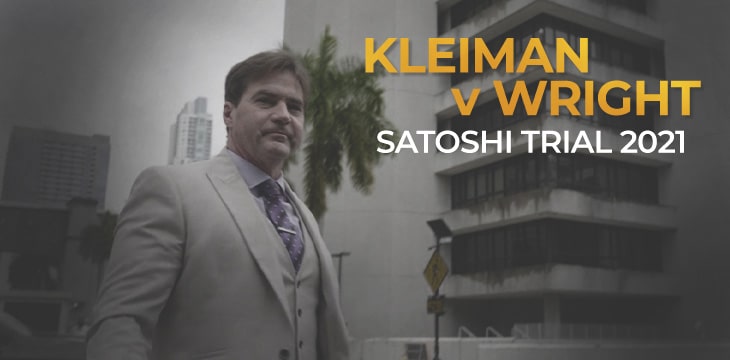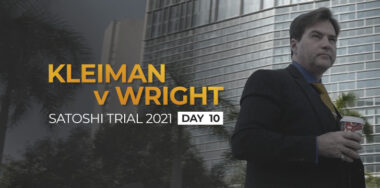In the years following Satoshi Nakamoto’s exit from public life in 2010, the growing number of investors and enthusiasts in the digital asset space could only guess at the inventor of Bitcoin’s real identity.
In the writings Nakamoto left behind, there were tea leaves to be read that might offer some insight into the person and process behind one of the most significant projects in modern history, but ultimately no way of knowing for sure.
This is exactly why four days with Dr. Wright under oath and on the stand have coincided with a peak number of spectators looking for a space in the public gallery. In the blink of an eye, the world has gone from an agonizing wait for Satoshi Nakamoto’s unmasking to having him spend four days giving sworn testimony in the most high-profile civil trial in living memory.
Now, after four days, Satoshi has left the stand. What did we find out?
The toll on Satoshi’s personal life
In the plaintiff’s attempts to corner Dr. Wright on the question of whether or not he invented and mined Bitcoin along with the late Dave Kleiman, it was inevitable that interesting and relevant details concerning the invention of Bitcoin would come out, too.
One of the most noteworthy of these came on Dr. Wright’s second day on the stand, where Vel Freedman confronted Wright with various instances where his description of the relationship between him and Dave suggested a more formal commercial relationship between the two than mere friends and sporadic collaborators.
Q. Dr. Wright, isn’t it true that it’s just not that Dave Kleiman co-created Bitcoin with you, but he also was the other half of Satoshi Nakamoto?
A. No. What is true is I exaggerated because Dave had no one remember him, and he was the most important person in my life for many years. I ended up –
At this point, Wright gets emotional. It’s clear as day that Dave Kleiman is a difficult subject for him, whatever the truth about his role in Bitcoin.
A: Sorry. I’m just trying to say this. It’s hard. I failed my first marriage because I didn’t talk to my wife. I was a director in an accounting firm. I was on partner track, and she didn’t want me to do this. And I talked to Dave and he talked me into it. I took a redundancy in December of 2008, and Dave talked me into doing that. He said follow my dreams. And despite my wife’s reservations, I didn’t even talk to her. I took the thing and just came home one day and said: Honey, I’m doing Bitcoin and I’m spending our money and I’m not going to work for two years.
I failed my marriage because I wanted to invent this thing, and Dave understood. So yes, he was critical to me. I don’t know how else to put it.
And yes, I was a terrible freaking husband. I put my invention over my marriage. And I’m sorry for that. And my first wife has forgiven me now. But I should never have done that. I should have talked to her. And I talked to Dave. And I put him before my wife, and I let him talk me into it. So yes, he was important. And for that, I told his father how important he was to me.
And he was. Always. I loved him.
This is the color and detail that could never be discovered by piecing together the unintentional clues left behind in Satoshi Nakamoto’s writings, but in hindsight it explains a lot. There has always been a strange hint of reluctance or even resentment from Satoshi Nakamoto. That much could be implied from his sudden exit from the project.
But to learn exactly how reluctant, where the reluctance came from and how it was overcome is entirely new.
On top of that, this portion of Dr. Wright’s testimony contained a sad implication regarding Dave Kleiman.
A: Now, I was led by Dave to believe that between when I told him to start mining and when I stopped mining, he was. I don’t know whether he did or not. If he did, it would be large.
No evidence has been produced which indicate that Dave was ever in possession of any amount of Bitcoin. What Wright seems to be saying here—perhaps somewhat reluctantly—is that he told his best friend to start mining Bitcoin at a time when doing so would have led to vast wealth as the coins appreciated over the following years.
Rather than take Wright’s advice, Dave Kleiman died destitute.
What Bitcoins are we even talking about?
Because the plaintiffs in this case are alleging that Dr. Wright and Dave Kleiman had a partnership to both invent Bitcoin and mine Bitcoin after its invention, Vel Freedman spent a lot of his time with Wright on the stand showing him every email involving Dave Kleiman which referenced Bitcoin, intellectual property or just the transfer of value generally.
But with Wright being involved with so many companies and with those companies holding often massive amounts of value, this led to the plaintiffs often overzealously claiming that all of these references must somehow be related to the creation of Bitcoin.
This led to a few embarrassing misstatements by the plaintiffs.
For example, take this exchange which occurred when Freedman was questioning Wright about agreements for the transfer of various amounts of Bitcoin.
Q. As part of this contract Dr. Wright, Dave was going to transfer you 250,000 Bitcoin, all his shares in W&K, and he was going to transfer 323,000 Bitcoin, right?
A. That’s what the document says.
Q. Dr. Wright, 250,500 plus 323,000. That’s about 570,000 Bitcoin that’s half of 1.1 million Bitcoin the Plaintiffs are claiming?
Q. Dr. Wright, 250,500, plus 323,000. That’s about 570,000, correct?
A. Approximately.
Q. Half of the 1.1 million the Plaintiffs are claiming in this case?
A. I’m not actually sure what the number the Plaintiffs are claiming in this case is. It’s never been mentioned.
At one point, Freedman seemed to feel he’d cornered Dr. Wright on an email he had supposedly sent where he described Dave as having mined Bitcoin through one of Dr. Wright’s companies.
However, Wright revealed that Dave had mined Bitcoin but only in one imprecise sense: the two had Bitcoin that existed only on the testnet which were being used to test Wright’s supercomputers.
Q. And the very next sentence Dr. Wright says the company he ran there mined Bitcoin?
A. Yes. It was running a test net version of that. I have a published paper on it. We tested Bitcoin running in my company up to 340 gigabytes, which was around 1 million transactions a second.
And the rate would enable that to be run at over a ten thousandth of a cent per transaction enabling global commerce for people in the third world for a lot cheaper than it is now. Yes.
As for the specific references to a stash of 1.1 million Bitcoin which appear throughout Dr. Wright’s communications (though, some of these details appear to have been sourced from the questionable Australian Taxation Office’s investigations into Dr. Wright), these have turned out to be a red herring. There’s no evidence that these were ever mined and on the contrary, it was revealed by Wright on the stand that these were purchased from a Russian exchange in 2011.
Dr. Wright has consistently maintained that he has been a purchaser of Bitcoin and specifically a purchaser of Bitcoin in 2011. A witness statement submitted to the Surrey Police in May of this year explained that some of the Bitcoins he had purchased from WMIRK, a Russian digital asset exchange, had been stolen by hackers in 2020.
Australia knew Dr. Wright was Satoshi Nakamoto
One thing that the plaintiffs absolutely must establish if they are to have any hope of winning this case is that Dr. Wright purposefully hid the identity of Satoshi Nakamoto from the world. They need to show this because it’s the only way they can explain the lack of any communication between Dr. Wright and Dave Kleiman regarding the alleged Satoshi Nakamoto partnership—a lack made stark by the constant back-and-forth between the two in other instances where they had partnered.
It was an assumption that Vel Freedman, the attorney for Ira Kleiman who was questioning Dr. Wright, wore on his sleeve, but one that for reasons elucidated in Wright’s response doesn’t make much sense:
Q. Dr. Wright isn’t it true that the an section of Bitcoin related emails between you and Dave Kleiman was by design?
A. No.
Q. And when I say that Dr. Wright, I mean that you made sure there were no such documents left; isn’t that correct?
A. No. I can’t delete any of Dave Kleiman’s emails. They were all available and all could have been accessed by Ira.
The implication that Dr. Wright managed to erase any trace of Dave’s involvement in Bitcoin from the history books is convenient for the plaintiffs, but highly improbable if not impossible, as pointed out by Wright.
We know that Dr. Wright didn’t go to Florida in the aftermath of Dave’s passing, and none of Dave Kleiman’s devices have ever been touched by Wright—all of these devices were taken by Ira Kleiman and either formatted and overwritten or handed off to strangers never to be seen again.
This fact was even part of the impetus for Dr. Wright reaching out to the Kleimans: Wright warned Ira Kleiman that there could be important data on Dave’s devices and that Ira should leave them alone. He didn’t listen.
So quite how Dr. Wright could have hoped to successfully delete all trace of Dave’s involvement with Bitcoin from both sides of the conversation is the plaintiff’s guess alone.
In any case, one of the more surprising parts of Dr. Wright’s testimony was that his identity wasn’t a total secret, even when the world was scrambling to unmask Bitcoin’s creator. At least, not in Australia. Which makes Dave’s own silence suspect:
Q. And, Dr. Wright, you heard your lawyers suggest to this jury that the fact that Dave Kleiman didn’t tell people about his creation and mining of Bitcoin with you somehow suggests he didn’t do it, right?
A. Yes. I told everyone. I told my mother, my family, the tax office, several other departments. Lots of people.
Q. But, Dr. Wright, you know that the truth is you and Dave Kleiman agreed to keep your partnership a secret; isn’t that correct?
A. No. I actually registered a company called Information Defense in Australia. I listed the shareholders. I recorded it with the Government and I sought a banking charter. So at least three, four hundred people knew that I was Satoshi in Australia. So no.
It’s startling to any of the thousands of people that have spent (and continue to spend) countless hours on getting to the bottom of the Satoshi Nakamoto mystery, and it’s important to see it confirmed under oath. But it’s not actually the first time such a thing has been suggested.
Australian financial cryptographer Ian Grigg has said the same thing in the past. According to Grigg, the secret that Wright was Satoshi Nakamoto was already well on its way into the public sphere at the time Wired and Gizmodo were preparing their grand reveal in 2015.
Harassment from the Australian Tax Office
As it turns out, Satoshi Nakamoto’s true identity being an open secret in Australia had severe consequences for Dr. Wright.
Dr. Wright has been open about years of what he terms harassment by the Australian Taxation Office (ATO): ceaseless letters, phone calls, audits and investigations which became so unbearable that Dr. Wright had to leave Australia.
A: I was getting 17 audits a quarter. They shut down my companies and didn’t stop until I had to leave Australia.
Dr. Wright and his attorneys have objected to the introduction of materials which purport to be from the ATO on the basis that they haven’t been authenticated and indeed have already been dismissed as inadequate by the Australian tax authorities.
Despite the objections, they were allowed at trial. Whether they did the plaintiffs any favor is another question.
A big part of the reason for the ATO’s interest in him and his companies was that he was upfront with the Australian government about his Bitcoin project from an early stage—long before the general public had an inkling that the inventor of Bitcoin was a computer scientist living in Australia.
Unfortunately, the early positions taken by the ATO would have almost certainly killed Bitcoin before anyone had a chance to realize its potential as digital cash. As Dr. Wright explained:
A: GST is like a sales tax, VAT. The Australian Tax Office wanted to put 10 percent tax on every Bitcoin transaction. There’s a public ruling, which I guess is equivalent to a Supreme Court ruling in America, that I brought between 2013 and 2014. That ruled that Bitcoin is basically not taxable under GST. So the tax office were fighting that and my company funded the whole anti-GST thing. And we had it overturned. So the tax office were pushing very, very hard to ensure that GST was applied to every Bitcoin transaction.
His feud with the ATO reached such levels of animosity that according to Wright, the ATO’s records are riddled with inaccuracies, omissions, and forgeries. Indeed, many of the documents introduced by Freedman when examining Dr. Wright were presented without official seals or even signatures. Dr. Wright was questioned over multiple poorly formatted transcripts purported to be records of interviews between the ATO and Dr. Wright and his representatives.

As a result, Dr. Wright could only express his problems with the records being presented. Freedman, reading a supposed transcript back to Wright, says:
Q. And then, Dr. Wright, you respond: We weren’t negotiating. We were partners for years. Do didn’t really negotiate.
A. This document is not an accurate transcript. It was rejected. The tax office that sent it through as draft. It was rejected by our lawyers. The – the tax office never came back with another one. So no, I did not say that.
Quite what the jury learned from any of this is hard to say, other than to be careful sharing your groundbreaking invention with the tax authorities.
Check out all of the CoinGeek special reports on the Kleiman v Wright YouTube playlist.
New to blockchain? Check out CoinGeek’s Blockchain for Beginners section, the ultimate resource guide to learn more about blockchain technology.








